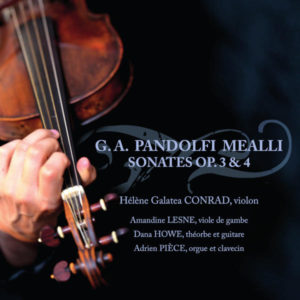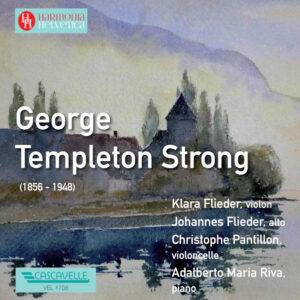Extraits / Excerpts
Handel - Le Jeune - Albinoni - Bartók: Works for Strings - Les Solistes Romands - Arpad Gerecz
Handel – Le Jeune – Albinoni – Bartók: Works for Strings – Les Solistes Romands – Arpad Gerecz
George Frideric HANDEL: Almira HWV 1: Chaconne – Chaconne in F Major, HWV 485 (Arr. For Strings, Ed. Schlesingerische) – Sarabande, HWV 437 – Sarabande, HWV 437: Variation (Ed. Schlesingerische) – Water Music Suite No. 1, HWV 348: VIII. Bourée – Claude Le JEUNE: Seconde Fantaisie – ANONYMOUS: Danses françaises (Ed. Schott): La petite Provence – Danses françaises (Ed. Schott): Les jolies filles – Danses françaises (Ed. Schott): Les noces – Danses françaises (Ed. Schott): Le carillon de Dunkerque – Tomaso ALBINONI: Sonata a 5 in G Minor, Op. 2, No. 6: I. Adagio – II. Allegro – III. Grave – IV. Allegro – Béla BARTÓK: For Children, Vol. 1, Sz. 42 (Arr. for Orchestra “10 Easy Pieces” Ed. Schott): No. 5 Kitty, Kitty (I. Poco allegretto) – No. 8 Girl’s Game (II. Allegretto) – No. 13 A Lad Was Killed (III. Andante) – No. 15 The Street of Istvand (IV. Allegro) – No. 18 In the Harbor of Nagyvarad (V. Andante non molto) – No. 32 The Sun Shines into the Church (VI. Allegro energico) – No. 37 When I Go Up Buda’s Big Mountain (VII. Poco vivace) – No. 49 Rogue’s Song (VIII. Andante) – No. 57 Bagpipe Tune (IX. Molto tranquillo) – No. 74 Bagpipe Tune (X. Vivace).
Les Solistes Romands, Arpad Gerecz, direction. (Wikipedia)
Introduction
With this record, the ensemble ‘Les Solistes Romands’ presents a selection of works they particularly enjoy, recorded during various concerts held in the church at Etoy.
Since its foundation in 1969, the ensemble ‘Les Solistes Romands’ has aimed to develop its artistic research by exploring little-known compositions, spanning from the Renaissance to contemporary music
The ensemble is composed of outstanding artists who hold leading positions in the finest orchestras of the French-speaking part of Switzerland. It functions in the true spirit of chamber music, prioritizing the pure pleasure of making music over profit-making.
The ensemble has chosen the violinist and conductor Arpad GERECZ as its artistic director. His extensive knowledge of string instruments and his great sensitivity as a soloist enable the ensemble to confidently tackle and master the challenges presented by diverse musical forms.
George Frideric HANDEL
Handel is widely known as the composer of The Messiah, Julius Caesar, and many other great vocal and instrumental works. Yet, beyond his typically Baroque structures, there is another Handel—more stripped-down, devoid of gold and purple. This is the Handel of the Concerti grossi and numerous orchestral suites.
The suite recorded for this disc features the famous ‘Sarabande’, which has been rendered in various transcriptions and transpositions. In this version for strings, it acquires a mellow and intoxicating quality. The work concludes with a ‘Hornpipe’, a dance with a sharply defined rhythm, a characteristic Handel borrowed from the English musical tradition while living in London.
Claude LE JEUNE
Relatively little is known about the life of Claude Le Jeune. He was born around 1525 in Valenciennes and passed away seventy-five years later in Paris. Fortunately, his works have been preserved. Le Jeune is unique among French composers of his time for cultivating such a wide variety of styles.
He wrote:
- 11 motets,
- 347 psalms,
- 146 airs,
- 42 Italian canzonettes,
- 1 mass,
- and 3 fantasies.
His work is characterized by a highly original harmonic language and remarkable rhythmic complexity. His contemporaries admired the effects created by his music, particularly during performances of his stately psalms, sometimes sung by over one hundred voices. These psalms were instrumental in spreading his fame beyond France’s borders.
In the ethereal nature and canon-like structure of his ‘Seconde Fantaisie’, one might perceive a distant precursor to The Art of Fugue, Johann Sebastian Bach’s spiritual testament.
Anonymous Dances of the French 18th Century
The French 18th century was an era rich in great artists, from Rousseau and Voltaire in literature to Rameau and Couperin in music. Alongside these sophisticated achievements, however, there flourished a more popular form of art.
The Anonymous Dances featured here strike a delicate balance between rustic charm and French elegance. By the 18th century, the French spirit had already developed the grace and clarity that would remain hallmarks of its artistic tradition up to the time of Ravel.
Tomaso ALBINONI
Born in Venice, Albinoni spent most of his life in his native city. His numerous instrumental works and forty-eight operas place him among the foremost Venetian composers, alongside Vivaldi and Marcello.
Albinoni’s art is captivating, marked by its melodic grace and structure. His music’s ability to enchant is immediate, drawing listeners in from the very first notes. The Sonata a cinque, op. 6 no. 2 carries an understated melancholy, amplified by its beautiful G minor tonality.
Béla BARTÓK
Bartók, a Hungarian composer, was also a renowned ethnologist and pedagogue. In 1908, he composed the ‘Dix Pièces faciles’ for piano, intended as practice material for young pianists. These pieces incorporate traditional Hungarian motifs, along with the major-minor contrasts so characteristic of Bartók’s work.
This collection of small pieces forms a series of miniatures, alternating between naivety and nostalgia. Like the French anonymous dances, these pieces reflect the soul of a people—diverse, ever-changing, and rich in tradition.
François Hudry
- Categories
- Composers
- Interprets
- Booklet












